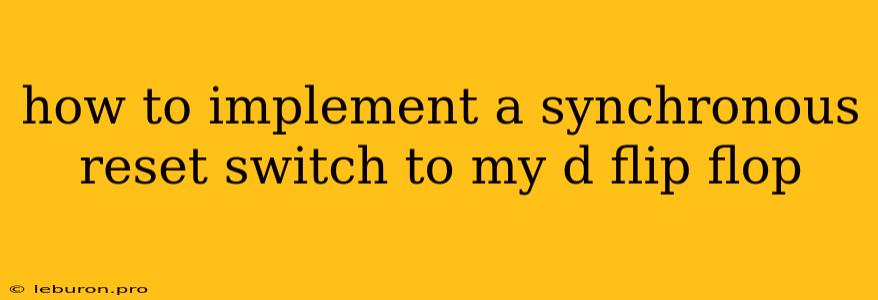How to Implement a Synchronous Reset Switch to Your D Flip-Flop
In digital circuit design, flip-flops are fundamental building blocks, responsible for storing and controlling data. While D flip-flops offer a simple and efficient way to hold data, sometimes we need to reset them to a known state. Implementing a synchronous reset switch offers a controlled and reliable way to initialize the flip-flop, ensuring predictable behavior in your circuit. This article will guide you through the process of adding a synchronous reset to your D flip-flop, explaining the advantages, different methods, and providing practical examples.
Understanding Synchronous Reset
A synchronous reset is a type of reset that occurs only when the clock signal is active. This means that the flip-flop will only reset when the clock edge (positive or negative) arrives. In contrast to an asynchronous reset, where the reset is active immediately regardless of the clock signal, a synchronous reset offers several advantages:
Advantages of Synchronous Reset:
- Predictability: Synchronous resets ensure that the reset operation occurs only at specific clock cycles, eliminating race conditions and unpredictable behavior. This is crucial for reliable and predictable system operation.
- Synchronization: Since the reset is synchronized with the clock, it avoids metastability issues, where the flip-flop can enter an unknown state during a transition between reset and data input.
- Clean Transitions: Synchronous resets guarantee that the flip-flop state changes only on a clock edge, resulting in cleaner transitions and better noise immunity.
Methods for Implementing a Synchronous Reset
There are several ways to implement a synchronous reset in a D flip-flop:
1. Using a Reset Input and Logic Gate
This method involves adding a dedicated reset input pin to your D flip-flop and using a logic gate to control the data input based on the reset signal. Here's how it works:
- Logic Gate: A simple AND gate is commonly used. One input of the AND gate is connected to the reset signal, and the other input is connected to the data input of the D flip-flop.
- Functionality: When the reset signal is active, the output of the AND gate is forced to 0, regardless of the data input. This effectively forces the flip-flop to reset. When the reset signal is inactive, the data input passes through the AND gate unchanged.
2. Using a Multiplexer
A multiplexer (MUX) can be used to select between the data input and the reset value based on the reset signal. Here's how:
- Mux Selection: The reset signal controls the selection input of the MUX.
- Data Input: The data input is connected to one of the MUX inputs.
- Reset Value: The reset value (typically 0) is connected to another MUX input.
- Functionality: When the reset signal is active, the MUX selects the reset value, forcing the flip-flop to reset. When the reset signal is inactive, the data input is selected, allowing data to be loaded into the flip-flop.
3. Using a Dedicated Synchronous Reset Flip-Flop
Some D flip-flops are designed with a dedicated synchronous reset input. This simplifies the implementation as the reset logic is already built-in. Simply connect the reset signal to the dedicated input, and the flip-flop will reset synchronously with the clock.
Example Implementations
Let's consider practical examples of implementing a synchronous reset using the methods described above:
Example 1: Using an AND Gate
Circuit Diagram:
┌──────┐ ┌──────┐
│ Reset │ │ │
└──────┘ │ AND │
│ └──────┘
▼ ┌──────┐
│ │ │
┌──────┐ │ │ D │
│ │ │ └──────┘
│ D │ │ ┌──────┐
└──────┘ │ │ Q │
│ │ └──────┘
│ │
│ └──────┐
│ │CLK│
│ └──────┘
▼
In this circuit, the reset signal is connected to one input of an AND gate, and the data input is connected to the other. The output of the AND gate is connected to the D input of the flip-flop. When the reset signal is high, the AND gate output is low, forcing the flip-flop to reset to 0. When the reset signal is low, the AND gate output is equal to the data input, allowing data to be loaded into the flip-flop.
Example 2: Using a Multiplexer
Circuit Diagram:
┌──────┐ ┌──────┐
│ Reset │ │ │
└──────┘ │ MUX │
│ └──────┘
▼ ┌──────┐
│ │ │
┌──────┐ │ │ D │
│ │ │ └──────┘
│ D │ │ ┌──────┐
└──────┘ │ │ Q │
│ │ └──────┘
│ │
│ └──────┐
│ │CLK│
│ └──────┘
▼
In this circuit, the reset signal controls the selection input of the MUX. One input of the MUX is connected to the data input, and the other is connected to the reset value (0). When the reset signal is high, the MUX selects the reset value, forcing the flip-flop to reset. When the reset signal is low, the MUX selects the data input, allowing data to be loaded into the flip-flop.
Conclusion
Implementing a synchronous reset switch in your D flip-flop offers numerous advantages, including predictability, synchronization, and clean transitions. By employing the appropriate methods, such as using a logic gate, a multiplexer, or a dedicated synchronous reset flip-flop, you can effectively control the initial state of your flip-flop. Choosing the method that best suits your specific application and circuit design will ensure that your flip-flop operates reliably and predictably. Remember that synchronous reset is a valuable tool for reliable and predictable digital system design, enhancing overall system stability and performance.
